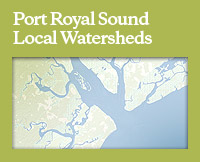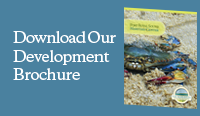 Blue Thumb
Blue Thumb
Welcome and Thank you for visiting our Port Royal Sound Foundation’s Blue Thumb page where you can learn about smart water practices to help keep our salt marshes healthy and dynamic and as a added benefit – you and your family healthy and active land and water stewards of our Port Royal Sound Area !
PRSF Blue Thumb Checklist take the pledge and become part of the Port Royal Sound Foundation's Blue Thumb family.
Potential hazards to Port Royal Sound ecosystem
Beaufort County is the perfect example of why this coastal region of the southeast is referred to as the Lowcountry. Our vast expansions of salt marshes and Sea Islands landscape are actually at and even below sea level elevation. We do not have the rolling hills of our coastal plain or upstate counties.
 And because of our topography and a few other items such as soil type and proximity to our groundwater, things in the Lowcountry tend to flow a little differently here than there ! Our rivers and creeks are tidal, meaning they are almost all exclusively influenced by the rise and fall of the Atlantic Ocean. However, the waters here are impacted by what happens in the Port Royal Drainage Area which extends into surrounding counties.
And because of our topography and a few other items such as soil type and proximity to our groundwater, things in the Lowcountry tend to flow a little differently here than there ! Our rivers and creeks are tidal, meaning they are almost all exclusively influenced by the rise and fall of the Atlantic Ocean. However, the waters here are impacted by what happens in the Port Royal Drainage Area which extends into surrounding counties.
Runoff is one example of how things tend to flow a little differently in the Lowcountry. Runoff comes in many forms including, rain from storms, hoses left on while washing cars, over-watered lawns, even improper drainage of swimming pools or ponds. Naturally, the runoff would slowly penetrate into the soil, the vegetation would filter out impurities, and there would be a clean recharge to our ground water. However, we have disrupted this natural flow by the desire to be so close to the salt marsh. As more people move to the coast, infrastructure increases and naturally vegetated areas decrease. We now have more impervious surfaces, such as rooftops, driveways, parking lots with little to no vegetation to slow the flow of runoff before it gets to the salt marsh. When we have a big rain event, large volumes of runoff move rapidly across impervious surfaces, funnel into storm drains and then dump right into our salt marshes.

Freshwater can be harmful to our salt marshes? It’s true !
Large volumes of freshwater runoff into our salt marshes stress this dynamic ecosystem. Beaufort county salt marshes are high in salinity and many of our marine organisms we love to see are adapted to this environmental condition. We must be mindful that even slight changes in salinity (28-30ppt, respectively) can be detrimental to larva and larva development of our marine organisms, including phytoplankton, crabs, even our beloved shrimp. The loss of those marine organisms would drastically affect the health of other organisms up the food chain like our sport fish, dolphins, sharks, and even alligators.
Pollutants and our salt marshes – the effects
Did you know that nonpoint pollution accounted for at least 70% of South Carolina’s oyster bed closures and harvesting restrictions? So you may wonder, “what is nonpoint pollution and how does this affect me?” The majority of nonpoint pollution is in the form of freshwater runoff. After a rain event, runoff flows over the ground and lots of materials are picked up and carried into the storm drain. Polluted freshwater runoff then enters, unfiltered into our salt marshes. Runoff can carry litter, debris, yard waste, pet waste, pesticides, herbicides, fertilizers, oil, metals, chemicals and bacteria, just to list a few. Some of those items, like metals and chemicals can persist a long time in our waters. Also, as metals and chemicals break down, they give off toxins that are often absorbed by our selfish, such as oysters, and other marine organisms. This can be extremely detrimental to the food chain, marine organisms, and also adversely impact human health. The health of our salt marshes are strong indicators of human health – the healthier an ecosystem, the healthier the people who cherish and care for it.
PRSF Blue Thumb – smart water practices for you – simple and easy!
YOU can do many things that are easy and low cost to help slow down and even limit the amount of freshwater runoff flow in Beaufort County. YOU will make an impact by keeping our waters free from pollution and encouraging others to do the same smart water practices. First, take time to print out and use our check off list to assess your surroundings. Determine your ranking and see if there are some things you can modify in your practices around your yard to get a higher ranking. We encourage you to become part of the PRSF Blue Thumb smart water movement. We would love to know your before and after ranking. Please don’t forget to email us about your progress to help keep our salt marshes healthy and dynamic.
PRSF Blue Thumb Checklist
Easy things you can do to help:
 Plant Buffers in Your Yard
Plant Buffers in Your Yard
Buffers are areas of planted vegetation that help to create a “buffer” between your yard and any body of water such as our salt marshes. Even if you don’t live on the salt marsh, planting vegetation can help reduce runoff. Every plant you encourage to grow will pull up and filter freshwater runoff and reduce pollution. Our Lowcountry Master Gardeners are willing to help you, visit http://www.lowcountrymga.org
 Set up a Rain Barrel
Set up a Rain Barrel
Rain barrels provide a great method for capturing water from your roof and gutters. You can use the water in your barrel to water your yard or gardens. Visit the Beaufort –Jasper Water and Sewer Authority to order your rain barrel at a reduce cost with Lowcountry Rain Barrels http://www.lcrainbarrel.com/
 Check for Leaks Inside and Outside
Check for Leaks Inside and Outside
Periodically check your toilets, sinks, showers, hot water heaters, dishwashers, and also lawn watering systems for any potential leaks.
 Don’t Overwater Your Yard
Don’t Overwater Your Yard
Be sure to check the weather; if it looks like rain, turn off your sprinkler system. A good one inch rain is perfect for most yards.
 Pick up pet waste
Pick up pet waste
It’s important to pick up after your pets. Check out the May River website to learn more http://www.neighborsforcleanwater.org/p/dog-waste.html




